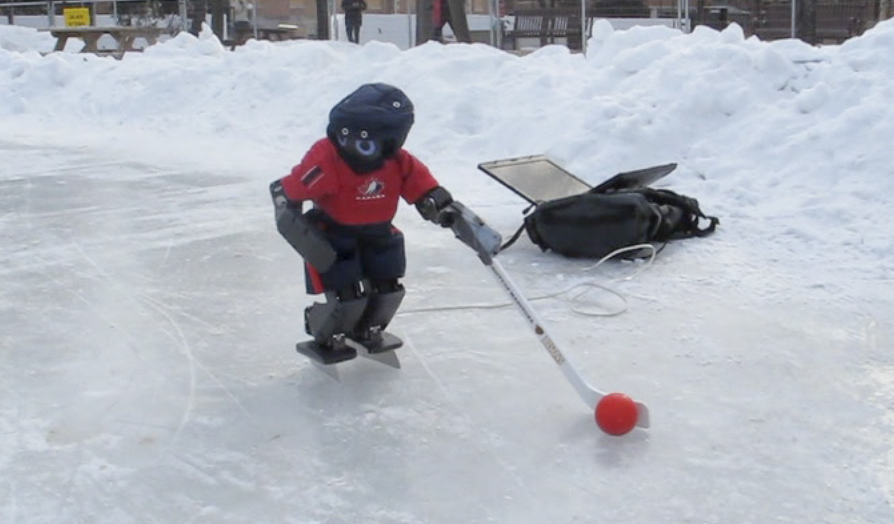If you’re daily commute around the U of M campus involves walking past or across the skating rink on the Quad, you may have recently seen Jennifer, the hockey-playing robot.
The brainchild of computer science, grad student Chris Iverach-Brereton and his supervising professor Jacky Baltes, Jennifer was programmed at the Autonomous Agents Laboratory on campus and is one of three DARwIn-OP humanoid robots that the university owns.
With a Bison mini hockey stick duct taped to one of her robotic arms and a pair of crude aluminum skate blades, Jennifer is a work in progress. She can keep her balance while shuffling along the ice, stickhandle with a ball or puck, and score goals with either a slap shot or backhand.
Iverach-Brereton put together a short video submission for the DARwIn-OP Humanoid Application Challenge being organized for the 2012 International Convention on Robotics and Automation (ICRA) in St. Paul, Minn. The video, uploaded to YouTube on Feb. 9, has over 37,000 views and major media outlets from Winnipeg and all across Canada have picked up the story.
We’re still far from the formation of a professional robotic hockey league. But, if Jennifer is selected as one of the finalists in the ICRA challenge, she might inspire teams from other parts of the world to start programming on their own hockey playing robots.
Iverach-Brereton explained in an interview with the Manitoban that soccer remains the most popular events at major robotic competitions, largely because of the sport’s international accessibility. Despite the simplistic rules of the game, robot soccer still provides the teams with a plethora of technical challenges to overcome — from visually tracking the ball and other robots, to mastering the mechanics of walking and kicking.
Iverach-Brereton also showed off another DARwIn-OP robot that had been modified and programmed to play a robot equivalent of basketball.
It seems plausible, then, if Jennifer’s progress continues, hockey might be the next sport adapted for and adopted in robotic competitions.
Following the university’s latest project in robotics had me thinking about the other recent advancements in robotics, and the role that artificial intelligence and robots might have in our society in the near future.
Boston Dynamics is perhaps the most interesting engineering company that I’ve come across in the robotics field. They specialize in the design and engineering of dynamic robots that often mimic nature—with uncanny results. Their website states that they receive funding from DARPA, the Defense Advanced Research Projects Agency, of the United States Department of Defense.
One of their most intriguing projects is named BigDog, a four-legged robot designed to handle rough-terrain and carry heavy loads. According to Boston Dynamics’s website, “The ultimate goal for BigDog is to develop a robot that can go anywhere people and animals can go.”
You can find a couple videos of BigDog tests uploaded to YouTube. In them, BigDog shows off its ability to walk up hills, climb over rubble and—in perhaps the most surreal moments of the clip—maintain its balance while walking on ice or after being kicked, all while carrying over 300 lbs of payload.
An even bigger version of BigDog designed by Boston Dynamics, named “LS3,” was recently profiled by MSNBC. Army Lt. Col. Joe Hitt, a representative from DARPA stated that LS3 “could provide real value to a squad while addressing the military’s concern for unburdening troops.”
There have already been well-documented instances of robotics and remote-controlled drones being used on the battlefield. It appears more robots, like LS3, are on their way. It will be interesting to see how these technological advances are applied to non-military purposes as well, such as: search and rescue missions or investigating the site of a natural disaster.
The future envisioned by 20th century science fiction writers—a world where autonomous robots and humans work side by side—is slowly but surely becoming a reality. Jennifer and LS3 exemplify the breadth of the range in which robots may eventually integrate with our society.
[vimeo clip_id=”36860437″]


